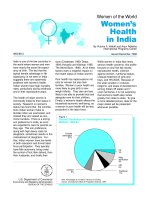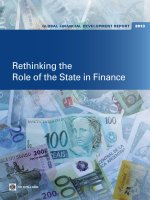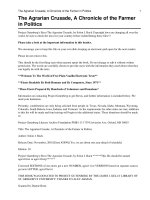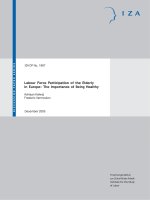Encountering the Past in Nature doc
Bạn đang xem bản rút gọn của tài liệu. Xem và tải ngay bản đầy đủ của tài liệu tại đây (1.9 MB, 187 trang )
_Encountering_
__the_PAst__
__in_NAture=_
=Essays_in=Environmental=History=
=edited_by_Timo=Myllyntaus_and_Mikko_Saikku=
ENVIRONMENTAL HISTORY
“This short book from a small country [Finland] is rich in imaginative, inno-
vative contexts. Ranging expertly over several continents, including North
America, it argues that nature is everywhere an active presence, a formative
influence, in the making of human history. An excellent introduction to the
kind of history most needed in the twenty-first century.”
—Donald Worster, Hall Distinguished Professor of American History,
University of Kansas
“In a field traditionally dominated by works on the United States, the [book
offers] a fresh international perspective, finding fertile ground for the study of
people and nature in diverse lands.”
—Economic History Review
A deeper understanding of contemporary environmental problems requires
us to understand the interaction between humans and nature in the past.
How have human societies affected their environment and vice versa? What
does history tell us about ecological change?
The essays in Encountering the Past in Nature provide various approaches to
the new discipline. Experts with diverse educational backgrounds tackle
important issues ranging from the intellectual formation of environmental
concepts to case studies of forest history and animal extinction. Most essays
focus on the issue of wilderness and the various uses of forest resources.
Introductory essays elaborate on the historiography and methodology of the
new field of historical study.
Encountering the Past in Nature is a welcome addition to the introductory
texts currently available in the United States.
Timo Myllyntaus is senior lecturer of economic and social history at the
University of Helsinki. Mikko Saikku is assistant director of the North
American Studies Program at the Renvall Institute for Area and Cultural
Studies, University of Helsinki.
SERIES IN ECOLOGY AND HISTORY
designed by Bonnie Campbell
=Ohio=University=Press=
_Encountering_the_Past_in_Nature_
_Encountering_the_Past_in_Nature_
Timo Myllyntaus and
Mikko Saikku, eds.
Ohio
ISBN 0-8214-1358-9
,!7IA8C1-ebd58g!
Encountering the Past in Nature
Ohio University Press Series in Ecology and History
James L. A. Webb, Jr
., Series Editor
Conrad Totman
,
The Green Archipelago: Forestry in Preindustrial Japan
Timo Myllyntaus and Mikko Saikku, eds.
,
Encountering the Past in Nature: Essays in
Environmental History
Encountering
the Past
in Nature
Essays in
Environmental History
Revised Edition
Edited by
Timo Myllyntaus and Mikko Saikku
Foreword by
Alfred W. Crosby
OHIO UNIVERSITY PRESS
Athens
Ohio University Press, Athens, Ohio 45701
Series Editor’s Foreword © 2001 by James L. A. Webb, Jr.
Copyright © 1999 Timo Myllyntaus, Mikko Saikku, the other
contributors, and Helsinki University Press
First published in Finland by Helsinki University Press, 1999
Second, revised edition, 2001
Printed in the United States of America
All rights reserved
Ohio University Press books are printed on acid-free paper
10 09 08 07 06 05 04 03 02 01 5 4 3 2 1
Cover art adapted from Mark Catesby’s eighteenth-century illustration of
the “Largest White Bill’d Woodpecker and the Willow Oak,” from
The Natural History of Carolina, Florida, and the Bahama Islands
(London, 1731–43)
Library of Congress Cataloging-in-Publication Data
Encountering the past in nature : essays in environmental history / edited
by Timo Myllyntaus and Mikko Saikku ; foreword by Alfred W. Crosby.
—Rev. ed.
p. cm. — (Ohio University Press series in ecology and history)
Includes bibliographical references and index.
ISBN 0-8214-1357-0 (alk. paper) — ISBN 0-8214-1358-9 (pbk. : alk.
paper)
1. Human ecology—History. 2. Nature—Effect of human beings
on—History. 3. Forests and forestry—History. I. Myllyntaus, Timo. II.
Saikku, Mikko. III. Series.
GF13 .E5 2000
304.2'09—dc21
00-057994
TM
Contents
Figures and Table vii
Series Editor’s Foreword
James L. A. Webb, Jr.
ix
Foreword
Alfred W. Crosby
xi
Preface xvii
Contributors xix
Environmental History: A New Discipline with Long
Tr aditions
Timo Myllyntaus and Mikko Saikku 1
Modernization and the Concept of Nature: On the
Reproduction of Environmental Stereotypes
Ari Aukusti Lehtinen 29
Life in the Borderland Forests: The Takeover of Nature
and Its Social Organization in North Karelia
Ismo Björn 49
The Vanishing and Reappearing Tropical Forest: Forest
Management and Land Use in Thailand
Olavi Luukkanen
74
vi
v
Contents
“Home in the Big Forest”: Decline of the Ivory-Billed
Wo o dpecker and Its Habitat in the United States
Mikko Saikku 94
Environment in Explaining History: Restoring Humans
as Part of Nature
Timo Myllyntaus 141
Index 161
vii
Figures and Table
Figures
1. Finland and the Baltic Sea Rim 6
2. The North Karelian Biosphere Reserve 51
3. Thailand 76
4. Major subdivisions of the Eastern Deciduous Forest
in the United States as it existed at the time of
European conquest 97
5. The original and late-nineteenth-century distribution
of the ivory-billed woodpecker in the United States 105
6. The pyramid of orientations in environmental history 154
Table
Key factors affecting the state of the environment in the
North Karelian Biosphere Reserve 53
ix
Series Editor’s Foreword
he Ohio University Press Series in Ecology and History is
pleased to publish Encountering the Past in Nature, a collection
of essays in environmental history by a group of Finnish scholars
that was ¤rst released by the Helsinki University Press in 1999. This
new edition provides a provocative and eclectic set of six readings
that is suitable for adoption in both world history and global envi-
ronmental history courses.
Three essays deal with change over time in forested zones, in
different parts of the Northern Hemisphere and in different histori-
cal periods—the northernmost forests of the European taiga, from
the Stone Age to the present; the subtropical lowlands of North
America in the period c. 1600–c. 1940; and the wet tropics of main-
land Southeast Asia, c. 1950 to the present. The other essays address
topics in historiography and intellectual history—the evolution of
historical writing about the environment in Finland and the United
States; the contradictory concepts about the natural world that in-
form We stern thinking about “nature”; and the role that the idea of
the environment can play as an explanatory factor in human his-
tory. There are essays in “big history” here, as well as challenging
case studies.
Encountering the Past in Nature also provides instructive exam-
ples of how environmental historians are working with a wide vari-
ety of interdisciplinary approaches to shed light on the complex
T
x
v
James L. A. Webb, Jr.
ecological processes of the past. Environmental historians are forg-
ing new perspectives by integrating data and insights from both the
natural and social sciences in order to write environmentally in-
formed history that speaks to our present-day concerns.
It may well be that no one of us can grasp the full complexity of
the historical and present-day transformations in global ecology.
However, contemporary environmental history scholarship, pushed
by the ecological imperatives of the early twenty-¤rst century, is
leading us to seek in that direction.
James L. A. Webb, Jr.
January 2000
xi
Foreword
istorians will always be busy—not because the past changes,
but because the questions we ask of it change as conditions
in our own times change. For instance, when the Romanovs and the
Habsburgs ruled, we often asked questions about dynastic rivalries.
Now, with the scions of aforesaid families outranked by movie stars
and pollution poisoning our skies, we ask questions about past
environments.
Our attention shifted not because environmental degradation is
new. That is not the case: Iraq’s southern reaches changed from
farmland to salty desert a very long time ago, and the Mediterranean
littoral lost its forest cover at least as long ago. Our attention shifted
because environmental problems, once local or, at worst, regional,
now loom as global. Worldwide warming of temperatures, expand-
ing ozone holes over the poles, the denuding of tropical forests—we,
historians and all the rest of us, fought hard to stay blind to such
phenomena, but the problems have won and have muscled their
way onto the front pages of our newspapers and into historians’
studies.
Proper consideration of the environmental threat requires intel-
lectual retooling. Scientists have to modify their predilection for the
tightly de¤ned problem with high walls around it to keep out “extra-
neous” information. Environmental problems, ¤guratively and lit-
erally, spill over the edges of laboratory benches and of reductionist
H
xii
v
Alfred W. Crosby
de¤nition. Environmental matters do not submit gracefully to sci-
enti¤c rigor. The heart as well as the head is often involved because
our convenience and even our lives are affected; and often the quality
of the data we use to de¤ne environmental matters is miserably poor
by the standards of physicists, chemists, and even ¤eld naturalists.
The scientists need the help of scholars, that is, people devoted
to exactitude and truth but accustomed to bias (their own in-
cluded) and to wringing truth out of dubious data. Scientists need
historians because historians can place environmental problems in
their chronological and cultural context. The scientists sometimes
seem to think that solving such problems is no more than a matter
of putting things right, and they have little idea of how subjective a
concept such as “right” can be. It certainly varies from society to so-
ciety and from time to time. For the environmental activist it often
means “natural,” that is to say, the way things would be but for the
intervention of humanity. But, as Ismo Björn shows us in his chap-
ter, humanity has shaped Finland, for instance, for a very long time,
and untouched nature has not existed there since as far back as the
last retreat of the glaciers.
For a politician and economist, “right” may mean desalinating
the west Texas farmland so that it can produce a pro¤t and support
inhabitants again. To the dedicated environmentalist, ornitholo-
gist, and shotgun manufacturer it may mean letting the river re¶ood
the ¤elds to reestablish fen country, providing endangered species
with a home again, giving ornithologists something to investigate,
and ensuring lots of ducks, and therefore duck hunters, thereby cre-
ating a market for shotguns. It is society, not science, that de¤nes
“right,” and it is historians who can supply a list of alternative
de¤nitions that society can usefully evaluate because it has lived
with them before.
On the other hand, environmental historians have a lot to learn
from the scientists. A liberal arts education, which is all that most
historians have, has prepared them to assess public appreciation of
environmental affairs and the intricacies of environmental politics,
but not to understand and evaluate what scientists have and have
Foreword
v
xiii
not discerned about the environment. It is no accident, as Timo
Myllyntaus points out, that Pehr Adrian Gadd, an early path¤nder
in environmental history, was the ¤rst Finnish professor of chemis-
try. Historians have to get used to charts, graphs, statistics, and the
scientists’ infuriating preference for the particular when the general
is what one wants to know about. It seems likely that science is hu-
manity’s greatest intellectual achievement, and historians have to
make their peace with it—or retreat to the questions inspired by
yesterday’s problems.
Finnish society has a special need for environmentalists, of both
the scienti¤c and historical variety. Its home is in the far north,
where the penalties for not paying attention to one’s environment—
for instance, whether the temperature has or has not been cold
enough for long enough to make it safe to drive the snowmobile
across the lake—are often immediate and irreversible. There is not,
I think, a technologically advanced society in the world whose leg-
ends and literature are so full of forests, waters, and wild animals.
From The Kalevala to Aleksis Kivi’s Seitsemän veljestä to the stories
and poems of the current generation of Finnish writers, nature
looms large.
It looms as large economically as emotionally. For all the suc-
cesses of Finnish technology—mobile phones, icebreakers, and
all—the nation’s most important export remains forest products.
As the old slogan goes, “Finland stands on wooden legs.” Her for-
ests seem to stretch on forever and, therefore, her economic future,
but so centuries ago did France’s, so a few generations ago did
southern Brazil’s. Environmental historians can supply the Finns
with dozens of object lessons of forests clear-cut to the ground by
villains, and, as well, with true tales of bugs and beetles, rusts and
fungi that have spread through forests thinned by the ecologically
unsophisticated. Finns need their forests for their peace of mind,
their export trade—for their futures—and therefore must learn to
think of them ecologically as well as economically.
Finns need to harvest their forests in accordance with the intent
of “sustainable yields,” but these are ambiguous words. The scientists
xiv
v
Alfred W. Crosby
may be able to tell what they mean, if all that they mean is that every
year there will be some kind of ground cover in the spring. But what
plants should be sustained? Factory forests with trees lined up like
potato plants? The wild, variegated sort of woodlands as they existed
before . . . before what? Before industrial lumbering? Before agricul-
ture? Historians like Lehtinen and Björn can tell us about what Finns
mean and have meant. Otherwise, forest policies will be driven by
mythic memories alternating with prophesies of wealth.
Demography and migration and, therefore, environmental
change in Finland has, for a century and more, been largely a mat-
ter of industrialization and urbanization. As recently as a genera-
tion or so ago the real Finn was supposed to be tending cattle
somewhere scores or perhaps hundreds of kilometers north of Hel-
sinki. That Finn remains the classic Finn, but increasingly most
Finns, or at least a plurality of such, live on or near the southern
coast and travel to the countryside, as Ari Lehtinen puts it, on vaca-
tions, in ¶ight “from the repressions of modern life in the cities.”
The forest is reoccupying some of the land it lost to the farmers and
loggers; starlings, which depend on meadows for access to their
food, are decreasing in number. Minor native ¶ora, kept in corners
and under fences by grazing cattle, advance again. Exotic plants es-
tablish themselves in reopening ecological niches. Historians can
enhance general understanding of such trends by putting them in
chronological sequence for us.
The old industrialization of William Blake’s “satanic mills” gave
rise to row on row of worker housing and to air and streams polluted
with soot, sawdust, and sewerage. The historians can tell us about
that and about how Finns perceived the threat and how they reacted
to it. The new industrialization of shiny white factories and vast
parking lots pollutes air and streams in new ways. The scientists can
tell us about that. The historians can help their fellow citizens to de-
cide not just what should be done about that (which may be obvious
in the abstract: stop it), but what measures are most likely to actually
work, given Finnish experience and general attitudes.
Foreword
v
xv
If experience were recorded as if by a tape machine in the brain,
so it could be played back in total for reanalysis in the light of fresh
events, then Finland, small though it is, would have spawned a
goodly number of the better environmental historians on earth. I say
that because experience has proved that the Finnish ecosystems—
land, lake, and sea—are delicate, easily disrupted, and slow to heal.
Historians can chronicle that at length and con¤rm that the rigors of
a far northern climate have always kept the margin for survival for
plant, animal, and human narrow. Clear-cut a Savo forest and you
will surely be in your grave before anything resembling the eco-
system you destroyed returns. Clear-cut a forest in Lapland, and it
will be centuries, even millennia—if ever.
v
Finns must take care of their country, must move as carefully
through their forests and fens as though through a house of cards.
A northern ecosystem may take longer in actual time than a house
of cards to collapse, but not in the foreshortened view of environ-
mentally impoverished grandchildren.
Finland’s historians have lessons for all peoples, for instance,
those of the United States, with its relatively forgiving midtemperate-
zone ecosystems. Even those systems cannot survive rapid and mas-
sive change unscathed, as Mikko Saikku’s story of the extinction of
the ivory-billed woodpecker illustrates. The lessons of Finnish en-
vironmental history are even more pertinent for peoples who live
in the midst of similarly delicate ecosystems, Siberians and Canadi-
ans, for instance. And it is not only northern lands that recover
slowly from ecological insult. Amazonia, Congo, Malaysia—these
and similarly hot, wet lands are as vulnerable to irreparable envi-
ronmental damage as Finland. Olavi Luukkanen tells us a tale of
forest management in Thailand that may differ in its details from
tales of forest management in Finland, but the lesson is the same.
Forests are increasingly hostages to general cultural attitudes and to
political trends.
xvi
v
Alfred W. Crosby
There seems to be only one group devoted to informing us
about our environments, our environmental attitudes, and our en-
vironmental politics. This is the new profession of the environmen-
tal historians, of which Finland has already produced several,
whose work you may read in the following pages.
Alfred W. Crosby
xvii
Preface
he globe has huge temporal dimensions. For ages barren nature
existed without living things. Life began on earth some 3.5 bil-
lion years ago, but modern humans (Homo sapiens) appeared per-
haps less than half a million years ago. Although latecomers among
the living things, humans as a species have transformed the earth the
most. Many of these transformations have not been bene¤cial to the
other species—nor to humans. Today ecological damage is not
merely a set of local phenomena. Environmental degradation is a
global problem.
Successive civilizations have faced environmental problems and
have sometimes been aware of causal factors underlying these un-
fortunate changes. Considering the gravity of degradation in many
cases, it is paradoxical that historical research dedicated to the study
of these topics did not begin until quite recently. This book aims to
contribute to the ongoing discussion in environmental history.
The foundation for this collection of essays was laid during the
seminars and series of lectures that we organized during the 1990s
at the University of Helsinki. On various occasions, we have had the
opportunity to share the enthusiasm of students of environmental
issues. We are indebted to the Faculty of Arts and the Faculty of So-
cial Sciences for providing us with funding for these events. We
have also had the privilege of becoming acquainted with dozens of
colleagues in the ¤eld and drawing on their wealth of knowledge.
T
xviii
v
Preface
We owe warm thanks to Dr. Alfred W. Crosby, Dr. Yrjö Haila,
and Dr. Yrjö Vasari, who have encouraged us to devise academic
coursework in environmental history and compile this anthology.
We also wish to express our gratitude to several referees who pro-
vided us with constructive suggestions and valuable criticism dur-
ing different stages of the writing and editorial process.
In editing the text, we received substantial assistance from Dr.
Frances Karttunen, Ms. Debra Rae Cohen, and Dr. Harvey Green,
whom we gratefully acknowledge. In addition, cordial thanks are
extended to Ms. Milla Laaksonen, our copy editor, who designed
the layout of the ¤rst edition.
In compiling this book, we have had the pleasure of working
with a group of dedicated and patient historians who have actively
participated in the editing process of their manuscripts. The chap-
ters in this book are more products of enthusiasm, aus Liebe zur
Kunst, than bread-and-butter jobs. Of course, without our academic
occupations as researchers and teachers, this book would never have
been completed. We have had pleasant facilities at the Department
of Social Science History and the Renvall Institute for Area and Cul-
tural Studies to do editing in addition to our daily work. We also
gratefully acknowledge the fellowships and grants awarded by the
Academy of Finland and the Ministry of Trade and Industry for our
primary occupations.
Timo Myllyntaus and Mikko Saikku
xix
Contributors
Ismo Björn
, Ph.D., Researcher at the Karelian Institute, Univer-
sity of Joensuu.
Alfred W. Crosby
, Ph.D., Academician at the Academy of Fin-
land, Professor Emeritus of Geography, History, and American
Studies at the University of Texas at Austin.
Ari Aukusti Lehtinen
, Ph.D., Professor of Geography at the
University of Joensuu.
Olavi Luukkanen
, Ph.D., Professor and Leader of the Tropical
Silviculture Unit at the Department of Forest Ecology, University of
Helsinki.
Timo Myllyntaus
, Ph.D., Senior Research Fellow at the Acad-
emy of Finland and Senior Lecturer of Economic and Social His-
tory at the University of Helsinki.
Mikko Saikku,
Lic. Phil., Assistant Director of the North Ameri-
can Studies Program at the Renvall Institute for Area and Cultural
Studies, University of Helsinki.
1
Environmental History
A New Discipline with
Long Traditions
v
Timo Myllyntaus and Mikko Saikku
nvironmental history has established itself in American aca-
deme since the 1970s. A similar development has taken place in
Europe, where human-induced changes have a much longer
and more far-reaching history. Although interaction between hu-
mans and nature has always been part of European historiography,
environmental history in the present sense of the term, with explicit
ecological consciousness, has been written for less than three decades.
This introduction concentrates on the rise of environmental
history as an academic discipline in Finland, and with reference to
the United States. From the viewpoint of environmental history,
these two countries have several things in common, and one reason
for the similarities is that in Finland and the United States the actual
takeover of nature by human populations was accomplished only
during the last three centuries.
What is environmental history, and what have the central
E
2
v
Timo Myllyntaus and Mikko Saikku
themes in the environmental historiography of the past century
been? Are there themes common to both American and Finnish
environmental history? Furthermore, how is environmental his-
tory viewed today by academe, and what will the future of the ¤eld
be? This brief prologue and the present set of essays aim to shed
light on these questions by trying to de¤ne environmental history
and by surveying the research and making comparisons between
differing approaches to the ¤eld.
Environmental history, in short, may be described as an at-
tempt to elucidate the interaction between humans and nature in
the past. How have human societies affected their environment
and vice versa? In comparison with traditional historiography, en-
vironmental history emphasizes the role of humans as an integral
part of their natural surroundings. Modern environmental his-
tory strives for a fuller understanding of today’s environmental
issues and may even provide data for contemporary problem solv-
ing. What ecological models does history offer us? Which have
been the adaptive and maladaptive human societies through his-
tory, and how did they function in their relations with the natural
environment?
Donald Worster and other American historians have offered
useful de¤nitions and have suggested approaches to the core of en-
vironmental history.
1
Important questions seem to center on the
various productive strategies of human societies, their ideological
backgrounds, and their consequences and comparisons across cul-
ture and place. What kind of society and environment emerge from
the interaction between these forces?
In his well-known essay, “Doing Environmental History,” Wor-
ster observes that there are three levels on which environmental his-
tory proceeds.
2
There is nature itself and the human socioeconomic
and intellectual realms as they interact with the natural environ-
ment. The most prominent approach in contemporary research is
probably the study of the interaction between human modes of pro-
duction and the environment. This ¤eld of study is concerned with
connections between the economy and environmental change in the
Environmental History
v
3
past.
3
Histories of environmental policy focus on environmental
change in relation to public control, especially legislation, while eco-
logical history attempts to reconstruct natural environments and
their changes in the past, relying heavily on the natural sciences and
their methodologies.
4
The intellectual realm is prominent in the his-
toriography of human ideas about the environment, or the study of
how humans have viewed the natural world in their science, reli-
gion, art, and ethics.
5
In environmental historiography, there has often been a delib-
erate effort to create an interdisciplinary synthesis, often by combin-
ing existing information from diverse disciplines in a new way. Not
surprisingly, the research topic tends to dictate the approach, source
materials, and research methods used. Thus the source materials
utilized in environmental history may vary enormously, from oral
histories and traditional written documents to data provided by
modern science, such as dendrochronology, and pollen and sedi-
ment studies.
The Rise of Environmental History
Although environmental history as a distinctive academic ¤eld
emerged only during the 1970s, its roots go back over a century.
Some scholars of the frontier and western schools of American his-
toriography, such as Frederick Jackson Turner, Walter Prescott
We bb, and James C. Malin, stressed the role played by the natural
environment in the formation of American society.
6
A similar ap-
proach can be identi¤ed in the work of their Finnish contemporar-
ies, the historian Väinö Voionmaa and the anthropologist Helmer
Smeds, who claimed that natural conditions had profoundly
shaped Finnish society.
7
Current Finnish research in the ¤eld has partly evolved from
this earlier, “instinctive” environmental history. In the agricultur-
ally unforgiving natural conditions of the Nordic countries, it has
been a common conviction that nature has always had a distinctive
4
v
Timo Myllyntaus and Mikko Saikku
impact on human activities; for centuries Nordic peoples have lived
“at the mercy of nature.” In the agricultural Finland of the past,
survival depended on the efforts of poorly connected communities.
With small local stocks of foodstuffs and weak communication fa-
cilities, there was no room for large errors of judgment. Tradition-
ally, Finns have been primarily interested in four environmental
themes: climate, forest, water resources, and landscape. This out-
look of the former farmer society has been re¶ected by academic
research. Like other scholars, historians have dealt with these piv-
otal elements of nature in their works.
In Finland, the tradition of research into climatic history has its
beginnings in the eighteenth century. The French school of econo-
mists, Physiocrats, and the Enlightenment in general inspired
scholars such as the ¤rst Finnish professor of chemistry, Pehr Adrian
Gadd, to register natural phenomena and climatic changes.
8
He
published widely on climatic impact on agriculture. Swidden culti-
vation and the dredging of rivers are other examples of the areas
explored in his multidisciplinary works related to environmental
issues.
9
The main emphasis in the early meteorological observations
was on weather conditions during the growing and harvesting sea-
sons, as well as annual temperature pro¤les. In the nineteenth cen-
tury, special attention was paid to deviations from the expected
seasonal temperatures, such as early night frosts or exceptionally
cold periods. In Finland, the growing season is short and unstable.
During the latter half of the twentieth century, the average monthly
temperature has annually been above freezing in the southern part
of the country for seven months and in Lapland for only ¤ve
months. Snow and frost limit the pasturing season to only a few
months. For these climatic reasons, conditions for agriculture have
been critical for a long time.
From the late seventeenth century to the third quarter of the
nineteenth century, marked harvest failures took place in Finland
roughly once in a decade, and three widespread famines per century
were not rare. In western Europe, the last massive harvest failure and









